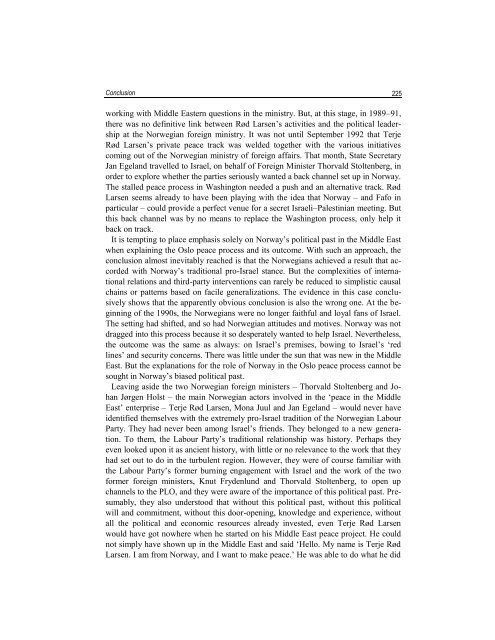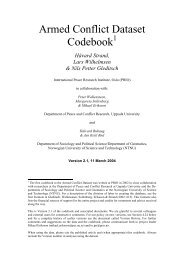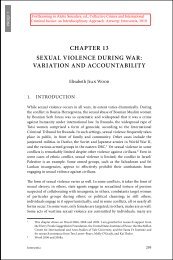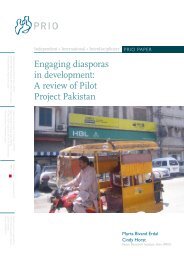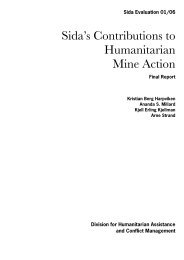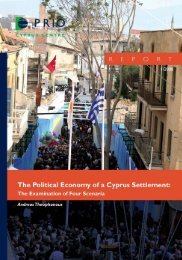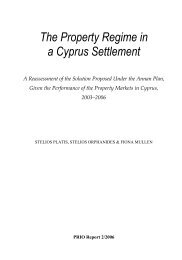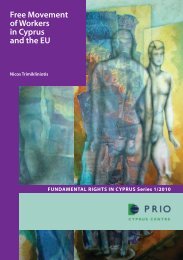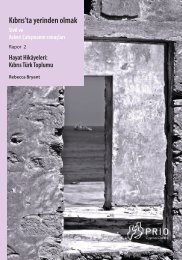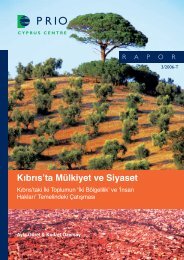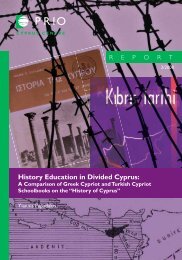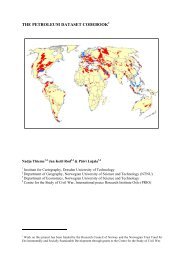Peacemaking Is a Risky Business - PRIO
Peacemaking Is a Risky Business - PRIO
Peacemaking Is a Risky Business - PRIO
Create successful ePaper yourself
Turn your PDF publications into a flip-book with our unique Google optimized e-Paper software.
Conclusion225working with Middle Eastern questions in the ministry. But, at this stage, in 1989–91,there was no definitive link between Rød Larsen’s activities and the political leadershipat the Norwegian foreign ministry. It was not until September 1992 that TerjeRød Larsen’s private peace track was welded together with the various initiativescoming out of the Norwegian ministry of foreign affairs. That month, State SecretaryJan Egeland travelled to <strong>Is</strong>rael, on behalf of Foreign Minister Thorvald Stoltenberg, inorder to explore whether the parties seriously wanted a back channel set up in Norway.The stalled peace process in Washington needed a push and an alternative track. RødLarsen seems already to have been playing with the idea that Norway – and Fafo inparticular – could provide a perfect venue for a secret <strong>Is</strong>raeli–Palestinian meeting. Butthis back channel was by no means to replace the Washington process, only help itback on track.It is tempting to place emphasis solely on Norway’s political past in the Middle Eastwhen explaining the Oslo peace process and its outcome. With such an approach, theconclusion almost inevitably reached is that the Norwegians achieved a result that accordedwith Norway’s traditional pro-<strong>Is</strong>rael stance. But the complexities of internationalrelations and third-party interventions can rarely be reduced to simplistic causalchains or patterns based on facile generalizations. The evidence in this case conclusivelyshows that the apparently obvious conclusion is also the wrong one. At the beginningof the 1990s, the Norwegians were no longer faithful and loyal fans of <strong>Is</strong>rael.The setting had shifted, and so had Norwegian attitudes and motives. Norway was notdragged into this process because it so desperately wanted to help <strong>Is</strong>rael. Nevertheless,the outcome was the same as always: on <strong>Is</strong>rael’s premises, bowing to <strong>Is</strong>rael’s ‘redlines’ and security concerns. There was little under the sun that was new in the MiddleEast. But the explanations for the role of Norway in the Oslo peace process cannot besought in Norway’s biased political past.Leaving aside the two Norwegian foreign ministers – Thorvald Stoltenberg and JohanJørgen Holst – the main Norwegian actors involved in the ‘peace in the MiddleEast’ enterprise – Terje Rød Larsen, Mona Juul and Jan Egeland – would never haveidentified themselves with the extremely pro-<strong>Is</strong>rael tradition of the Norwegian LabourParty. They had never been among <strong>Is</strong>rael’s friends. They belonged to a new generation.To them, the Labour Party’s traditional relationship was history. Perhaps theyeven looked upon it as ancient history, with little or no relevance to the work that theyhad set out to do in the turbulent region. However, they were of course familiar withthe Labour Party’s former burning engagement with <strong>Is</strong>rael and the work of the twoformer foreign ministers, Knut Frydenlund and Thorvald Stoltenberg, to open upchannels to the PLO, and they were aware of the importance of this political past. Presumably,they also understood that without this political past, without this politicalwill and commitment, without this door-opening, knowledge and experience, withoutall the political and economic resources already invested, even Terje Rød Larsenwould have got nowhere when he started on his Middle East peace project. He couldnot simply have shown up in the Middle East and said ‘Hello. My name is Terje RødLarsen. I am from Norway, and I want to make peace.’ He was able to do what he did


